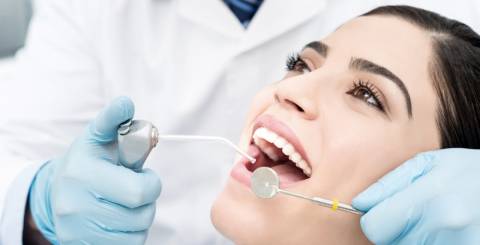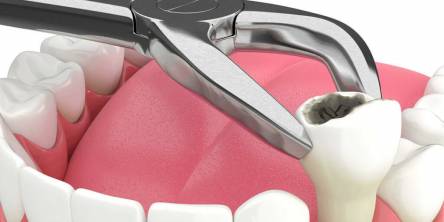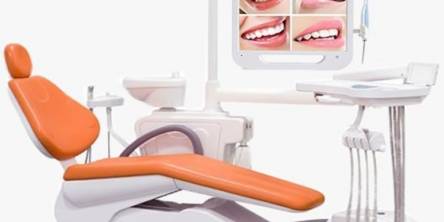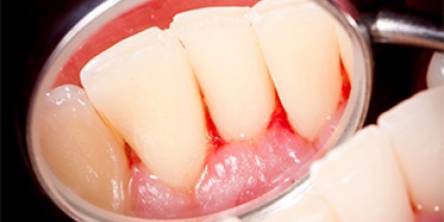9 Symptoms of Gum Diseases and Treatments! Necrotizing Gingivitis

Necrotizing gingivitis is part of a range of disease known as necrotizing periodontal diseases. Necrotizing Ulcerative Gingivitis (NUG) is a severe infection of the gums (gingiva) characterized by gum necrosis, bleeding, and pain. It is diagnosed once specific clinical signs and symptoms begin to develop. It is different from other gum diseases in that it presents with necrosis of gums between teeth ulceration of the papillae, gum bleeding, and pain.
It usually occurs in young adults between the ages of 18-30 years. It is also known as Vincent's Infection, acute ulcer membranous gingivitis, phagedenic gingivitis, fusospirochetal (related to, or caused by Fusobacteria and spirochetes) gingivitis or Trench Disease (due to its outburst in the soldiers during World War 1).
Symptoms
- The rapid or sudden onset of intense pain (localized or generalized).
- Ulcerated and necrotic papillary and marginal gingiva and cratering (punched out) of papillae.
- Intense gingival pain.
- Gums that bleed easily.
- Bad breath.
- Yellowish-white or grayish slough “pseudomembrane” (skin-like tissue) covering ulcerated papilla, swollen or enlarged lymph nodes, fever, and fatigue.
- The Bacterial attack on gum tissues.
- Severe/excruciating pain.
- Lesions or blister-like formations on the gum and gum line.
Risk Factors
- Risk Factors may include the following:
- Psychological anxiety and stress.
- Sleep deprivation.
- Smoking.
- Pre-existing early-stage gum disease (gingivitis) and trauma.
- Inadequate oral hygiene.
- Nutritional Deficiency.
- HIV-positive status.
- Other medical conditions that weaken immunity.
- Immunity-suppressing medication, such as corticosteroids.
- Down’s Syndrome.
- Sudden lifestyle change.
- Males are more at risk than females.
- All the factors mentioned above result in immunosuppression: decreased antibody response, increasing one's vulnerability to the infection.

Diagnosis
- Detailed medical history, including nutrition, lifestyle and health habits.
- Medical consultation and treatment, in case the immunosuppressive disease is suspected.
- Detailed dental account: pain (persistent, intense onset).
- Extraoral examination: for enlarged and swollen lymph nodes of the head and neck.
- Intraoral examination: for clinical features of NUG and the presence of pasty saliva.
- Based on the professional medical check-up, a diagnosis of NUG is established.
Treatment
- Common Initial phase Treatments include:
- Debridement of the infected area which is under local anesthesia.
- Removal of the formed membrane using cotton dipped in chlorhexidine.
- Explain to the patient-specific oral care instructions such as the use of a prescription antibacterial mouthwash: chlorhexidine 0.12% twice daily.
- Manage pain with analgesics: ibuprofen 400-600 mg thrice daily.
- Patient counseling should include education on proper nutrition, oral care, appropriate fluid intake, and quitting of habits such as smoking.
- Antibiotics if patiently is immunocompromised (e.g., AIDS, leukemia,) or in case of development of physical symptoms like fever, malaise, and enlargement or swelling of lymph nodes.
- Follow up with a complete oral examination after the resolution of the condition.
- When the physical manifestation of the disease such as fever is present, antibiotic treatment may be recommended.
- Remaining soft tissue hollows are more vulnerable to further dental attachment loss; these areas may need surgical treatment in the future to avoid complications.
- Sites that don't respond to treatment may occur and may be characterized by recurring and progressive deterioration of the gum and surrounding structural detachment.
- Reasons for unresolved NUG include the failure to remove the irritant, incomplete debridement of infected tissue, inaccurate diagnosis, a patient who doesn't follow treatment protocols and medication, and underlying medical conditions.
- Non-resident patients will need additional therapy, additional medication, and dental consultation. These conditions may tend to recur; therefore, frequent periodontal maintenance visits and thorough oral hygiene are mandatory.
- Your dentist may recommend medicated mouth rinses, brushing with special toothpaste and flossing more frequently to meet your increased need for oral hygiene.
- Untreated, the condition may lead to rapid deterioration of the gum (necrotizing ulcerative periodontitis) and may also spread, as necrotizing stomatitis or noma, into surrounding tissues in the cheeks, lips or the bone structure of the jaw.
- With treatment, even if attachment loss occurs with NUG, resolution post-treatment (regular scaling, root planing, and antimicrobial or rinses), is quick and regeneration of the impacted soft tissues is possible.
Read more: Gingivitis Causes And Treatment

Oral diseases such as acute necrotizing gingivitis flourish easily in people with a compromised immune system. A strong immune system can fight off deadly viral and bacterial infections. Eat a healthy balanced diet with plenty of immunity-boosting nutrients to avoid falling prey to these painful and damaging oral diseases.”
Oral diseases can be easily prevented with professional dental deep cleaning, good oral hygiene, and balanced meals. Regular dental examinations can also help detect gum diseases in early stages. It can be advantageous as early detection can prevent the pain and damage caused by the advancement of the disease. The outcome is always better when medical intervention happens early.
Similar Articles
Ah, the bittersweet moment when a tooth has overstayed its welcome. It’s been with you through thick and thin—chewing your favorite snacks, smiling in photos, and grinding during those stressful nights. But now, it’s time to part ways
Learn 5 signs you may need dentures and discover the steps to get started for a healthier smile and improved quality of life.
Boost patient trust and diagnostic accuracy with high-quality intraoral cameras. Enhance care, improve communication, and streamline operations in your dental practice!
Imagine this: You just walked out of the dentist's office after your laser gum contouring procedure, and your smile is on the verge of greatness: no more gummy grins or uneven gum lines. You’re practically ready to hit the red carpet. But hold up — what happens next? How fast can you expect to heal after your gums get their laser makeover?
Have you ever wondered how orthodontic treatment has evolved over the years? Are you curious about the latest innovations in teeth straightening technology? Have you heard about Invisalign but aren't quite sure how it works or if it's right for you? If you've found yourself pondering these questions, you're not alone.
Gingivitis is an inflammation of the gums that often develops unnoticed in the early stages. However, if left untreated, it can lead to severe complications. In this article, we look at five essential facts about gingivitis that will help you better understand this disease and take the necessary steps to prevent and treat it.
Everyone is looking for that movie star smile but we think to ourselves that it’s going to cost too much money and so we give up on the dream. You would be surprised at what can be achieved at your local dental clinic and people have gone in through the doors and came out a short time later with an unbeatable smile that may be even better than the TV and movie stars that we see every single day
Dental implants fundamentally changed the concept of replacing teeth.
Cosmetic dentistry is a branch of dentistry that focuses on enhancing the function and appearance of a patient's smile. Cosmetic dentistry near you is frequently elective, but it can provide numerous restorative benefits. Depending on the type of cosmetic treatment you have, most are rather easy, while some are more difficult









